Roberts named fellow of American Mathematical Society
Rachel Roberts, a professor of mathematics at Washington University in St. Louis, has been named a fellow of the American Mathematical Society for 2026.
Measuring the stars
WashU’s Performing Arts Department in Arts & Sciences will present “Silent Sky,” which explores the life and work of celebrated astronomer Henrietta Leavitt, in the A.E. Hotchner Studio Theatre Nov. 20-23.
Seniors Abdelmoity, Karinshak were Rhodes Scholars finalists
Washington University in St. Louis seniors Omar Abdelmoity and Marilee Karinshak were finalists for the Rhodes Scholarship, one of the globe’s highest academic honors.
A new angle of study for unveiling black hole secrets
Physicists from Washington University in St. Louis share results from an international collaboration for measuring the hard X-ray polarization from the black hole Cygnus X-1.
Drilling deep to study the oxygenation of Earth
David Fike, a researcher at Washington University in St. Louis, is helping to lead the American contingent of a $3.1 million international drilling project investigating a landmark shift in Earth’s evolution.
‘Something is Happening’ Nov. 14-16
“Something is Happening,” the 2025 WashU Dance Theatre performance, will take place Nov. 14-16 in Edison Theatre. The evening-length concert will feature original works by visiting choreographers Ron K. Brown and Xi Zhao, by faculty choreographers Elinor Harrison and David Marchant, and by graduate student Liz Lloyd.
Yang honored with American Physical Society fellowship
Li Yang, the Albert Gordon Hill Professor of Physics at WashU, has been named a 2025 fellow of the American Physical Society.
Students produce film at Prague’s prestigious FAMU
As study-abroad students at the Film and TV School of the Academy of Performing Arts in Prague (FAMU), WashU seniors Marielle Morrow and Cole Bernstein wrote, directed and edited “A Bird in the Field.” The movie screens at the St. Louis International Film Festival Nov. 15.
Kenneth F. Kelton, professor emeritus of physics, 71
Kenneth (Ken) Franklin Kelton, the Arthur Holly Compton Professor Emeritus of Physics at Washington University in St. Louis, has died following complications from lymphoma treatments. He was 71.
Why did ancient people build Poverty Point?
Researchers at Washington University in St. Louis suggest new explanations for iconic prehistoric sites at Poverty Point in Louisiana.
View More Stories









